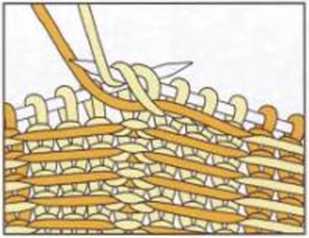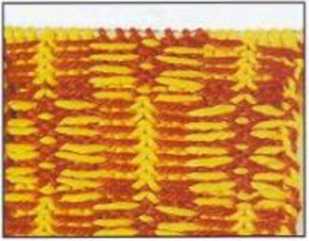145

Jacquard Patterns



Weaving In Yarn Carried Across the Back of the Work
If you are working large jacguard patterns, where the inJiviJuaI parta of the design are morę than 7 stucho npsirr, you stawki occasionaily wcnvc in the yam you are not using, or even \veavc it in contimiously.
If yiKi u.se the \vcaving techntque in other woali, i!’you wcnve in the yam not lnring used coiuinuously— the appcarance of the sritches c.m casily bccomc irregular on ilu- front of t he work and rhe colors of the yarn bcing carried on the back cnn show through on the front. For thts reason. the yarn bcing woven in always has to be pulted up rather tight. Also, the knitting usually becomes tighter than norma! in Jacguard patterns hecausc of the yam heing woven tn.
For a hetter overview. rhe drnwings show the yam \voven tn at only 1 point (pluito.it bortom). Make surę that as you are knitting, you always havc the same yam color at rhe front of your forctlngcr. otherwhe you won't bc ablc to reproduce the steps shown tn the drawings. Hero the yclkiw yam is at the front, rhe msr-colored yarn at the hack.
IOn the right sido rows, ałter-nately knit the front yarn nor-mally. Then insert right needln into the stitch, bring the tip of the needle over both yams to the back. catch the front yarn from top to bottom, and bring it forward and through the stitch. passing over the back yarn.

3 On the wrong side rows,
alternately work the front yarn normally Then catch it going over the back yarn.
2Alternately knit the back yarn normally, then catch the yarn going under the front yarn.
Alternately work the back yarn normally. Then insert the right needle into the stitch. bring the tip of the needle over the front yarn from the front, catch the back yarn from top to bottom, and bring it forward and through the stitch, passing over the front yarn.

Long pieces of yarn carried at the back of the work are woven in at 1 or moro points.

If you use the weaving technigue for every stitch, the piece gets very stiff. łf the yarn is heavy. the woven yarn can show through on the right side of the work.

A view of continuous weaving from the back. Here, alternately work 1 stitch “normally," using the jac-quard techniąue (page 142), and 1 stitch using the weaving technigue.
Wyszukiwarka
Podobne podstrony:
Extracting the Install Archive To install MySQL manually, do the following: 1. If
math patterns2(1) ^.KidZone.^ Name: _ _ math readiness Look at the pattern in each row. Circle the p
Picture 4 Changing Lower Body Parts Transportation devices can be attached in place of the lower bod
image002 ROGER ZELA2NY WAS ONE OF THE BRłGHTEST UGHTS IN SCIENCE FłCTION AND FANTASY...FANS OF HIS
the leaders in Iow Cost Professional Quality CAD softwareLook for the IMEW family of software If you
2b (45) b) Chloride attack The chloride ions may be present in the concrete if the
85 Figurę 3.2 Variation in body mass over the experimental period. Data are least sąuare means of bo
Knit-in Facings and vests, the front facings can l>e knit as you are working the piece
“BOBBY" METZGER The Coming Scientist If you are thinking of buying a Home in Salem, or a Farm i
81160 stronaE (3) Lead-in 1 a Which rooms from the box can you see in the photos? bathroom bedroom d
186 Yci ypOKM 3Hr/iii/icbKOi mobu. 5 K/iac (3a niflpyHHMKOM O. Kapn iOK) Group C. Taxi If you are in
essent?rving?99 C A R V 1 N C IN THE R O U X D CON VEYING A SENSE OF DEPTH If you are drawing with a
s&h 076 TG STRENGTH AND HEALTH If you are inclined to licart trouble, nevex* entirely submerge the b
BVCommunityP20 Skill: Counflng ponntes ar>d nickelsAt the Craft ShopCount the coins in each row.
więcej podobnych podstron